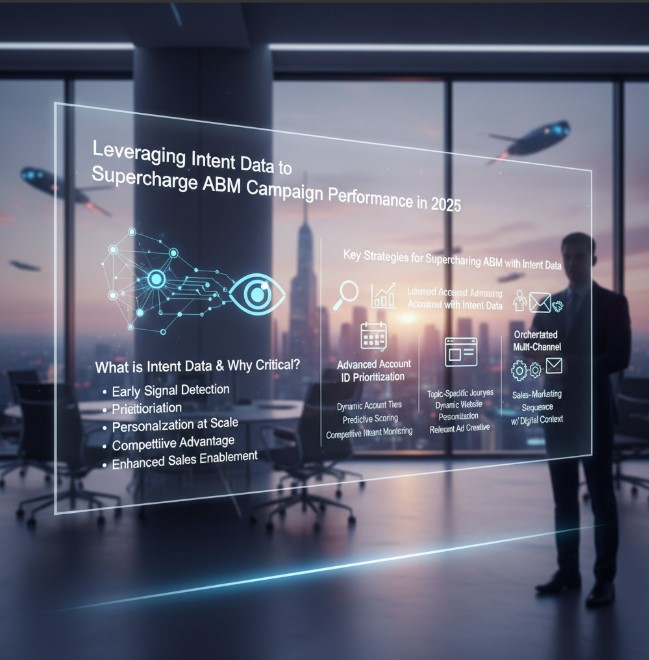Account-Based Marketing (ABM) has evolved from a niche strategy into the most powerful growth engine for B2B enterprises. But in 2025, success isn’t just about targeting the right accounts—it’s about understanding where those accounts are in their buying journey and what they care about right now.
That capability comes from intent data.
Intent data gives ABM teams real-time behavioral intelligence about which accounts are actively researching solutions, evaluating vendors, or preparing to purchase. When used effectively, intent insights allow marketers to prioritize best-fit accounts, deliver hyper-personalized experiences, and accelerate deal cycles—all while reducing wasted spend.
This guide breaks down how intent data fuels modern ABM and the strategies top-performing B2B brands are using to transform insights into revenue.
What Is Intent Data & Why It Matters in ABM
Intent data tracks signals that show when a company is researching a particular product, service, or topic—long before they fill out a form or speak to sales.
There are two key types:
TypeSourceValueFirst-Party IntentWebsite actions, email engagement, webinar interactionsReveals high-engagement accounts already in your funnelThird-Party IntentContent consumption across external sites and search behaviorIdentifies net-new accounts actively researching solutions
✅ Why intent matters for ABM:
- Helps prioritize accounts based on active buying signals
- Enables personalized, contextual messaging
- Improves sales and marketing alignment with shared intelligence
- Captures in-market buyers before competitors engage
In short: Intent data turns ABM into a proactive revenue strategy—not a guessing game.
Challenges in Traditional ABM (Without Intent Data)
Even mature ABM teams often struggle with:
❌ Targeting accounts that show no actual buying readiness
❌ Low engagement due to generic messaging
❌ Long sales cycles with high drop-off rates
❌ Misalignment between SDRs and Marketing
❌ Revenue leakage due to missed deal signals
Intent data fixes these gaps by revealing where demand already exists.
How Intent Data Improves Every Stage of ABM
1️⃣ Account Prioritization
Replace static account lists with dynamic, real-time prioritization.
→ Focus resources only on high-intent, high-fit accounts.
2️⃣ Buyer Persona Mapping
Identify which stakeholders are engaging and tailor content to their specific roles and concerns.
3️⃣ Personalized Outreach
Buyer research triggers → tailored messaging:
- Researching pricing? → Send ROI case studies
- Exploring competitors? → Share comparison guides
- Searching for integrations? → Highlight product ecosystem
4️⃣ Sales Activation
Sales teams receive alerts when accounts spike in intent:
📍 Know when to call
📍 Know what to say
5️⃣ Pipeline Acceleration
Intent-driven nurturing eliminates guesswork, resulting in:
✅ Faster deal velocity
✅ Higher conversion rates
✅ More predictable pipeline growth
Proven Strategies to Use Intent Data in ABM
✅ 1. Build Intent-Based Target Account Lists
Use intent scoring + ICP criteria to refresh targeting weekly or monthly.
✅ 2. Create Personalized Content Journeys
Example personalization by stage:
Intent LevelBuyer StageRecommended ContentLowAwarenessBlogs, infographics, explainer videosMediumConsiderationWebinar invites, industry researchHighDecisionDemos, case studies, pricing
✅ 3. Align SDR Teams with Real-Time Alerts
Trigger outreach sequences immediately when accounts show purchase signals.
✅ 4. Activate Multi-Channel ABM
Distribute dynamic content across:
- LinkedIn ads
- Display advertising
- Web personalization
- Events & webinars
✅ 5. Measure What Matters
Set revenue-focused KPIs:
- MQAs created
- Pipeline generated from intent-qualified accounts
- Meeting booked from intent triggers
- Deal velocity & win rates
Top Tools for Intent-Driven ABM in 2025
CategoryToolsIntent Data ProvidersBombora, 6sense, G2, DemandbaseCRM + AttributionSalesforce, HubSpotAdvertising ActivationLinkedIn Marketing Solutions, RollWorksAnalytics & VisualizationTableau, Power BI
The key is integration—one source of truth for buyer intelligence.
Future Trends: Where Intent Data Is Heading
🚀 Predictive Buying Signals
AI will forecast future purchasing—not just current research.
📍 Persona-Level Intent
Understand exactly which decision-maker is influencing the deal.
🔐 Privacy-First Intent Strategies
More first-party data sourcing as third-party restrictions increase.
🤖 Automated ABM Workflows
Intent triggers will directly launch nurture campaigns and SDR tasks.
Intent-powered ABM will become the default GTM strategy in enterprise B2B.
Bonus Tips to Maximize Impact
✅ Refresh your intent-based account list every 30 days
✅ Share insights transparently between Sales + Marketing
✅ Use content variants for each stakeholder
✅ Test dynamic personalization across paid channels
✅ Track pipeline—not just engagements
Small shifts in activation yield big gains in revenue performance.
Conclusion
In 2025, intent data is no longer a competitive advantage—it’s the cost of entry for scalable ABM success. By uncovering real-time buying behavior and aligning experiences to prospect needs, brands can generate predictable pipeline faster and smarter.
Whether you’re improving sales efficiency, reducing wasted spend, or accelerating growth—intent data supercharges every step of ABM execution.
🔗 Ready to transform your ABM strategy using intent insights?
Convert intent into revenue—one account at a time. 🚀
